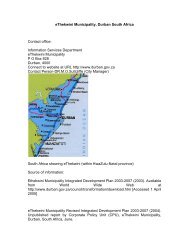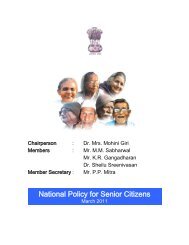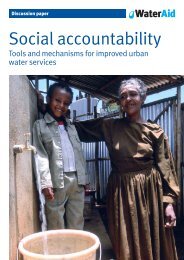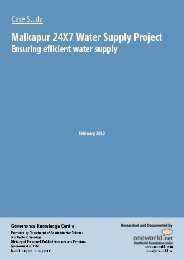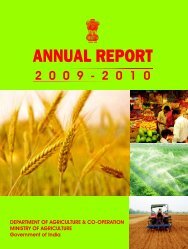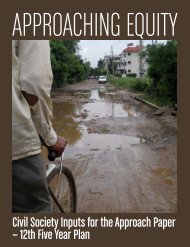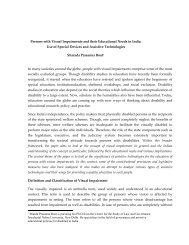Delivering Financial Inclusion Services to Rural Citizens through the ...
Delivering Financial Inclusion Services to Rural Citizens through the ...
Delivering Financial Inclusion Services to Rural Citizens through the ...
You also want an ePaper? Increase the reach of your titles
YUMPU automatically turns print PDFs into web optimized ePapers that Google loves.
<strong>Delivering</strong> <strong>Financial</strong> <strong>Inclusion</strong> <strong>Services</strong> <strong>to</strong> <strong>Rural</strong> <strong>Citizens</strong> <strong>through</strong> <strong>the</strong>Common Service CentersAn Evaluation of State Implementation ModelsMarch 2011
<strong>Delivering</strong> <strong>Financial</strong> <strong>Inclusion</strong> <strong>Services</strong> Through <strong>the</strong> Common Service CentersTable of ContentsI. Introduction .................................................................................................................................................. 3II. <strong>Financial</strong> <strong>Inclusion</strong> & CSC Scheme: Experience from States ........................................................................... 41. Implementation Model Case Studies ................................................................................................................ 42. The BC- CSC Business Model: Enabling Kiosk Banking ...................................................................................... 83. Estimated Revenue from Delivery of <strong>Financial</strong> <strong>Services</strong> ................................................................................... 94. Government Scheme Linkages Ensure Sustained Banking <strong>through</strong> CSCs ......................................................... 95. Key Success Criteria ........................................................................................................................................ 106. Roles of <strong>the</strong> Key Stakeholders ......................................................................................................................... 11III. Recommended Actions for CSC SPV ............................................................................................................ 12IV. Conclusion ................................................................................................................................................... 13V. Annexure 1: Updates from States................................................................................................................ 14VI. Annexure 2: Aisect BC & Remittance Performance Report ‘10-11 ............................................................... 152
<strong>Delivering</strong> <strong>Financial</strong> <strong>Inclusion</strong> <strong>Services</strong> Through <strong>the</strong> Common Service CentersI. IntroductionOn September 28, 2010, Reserve Bank of India (RBI), as part of its <strong>Financial</strong> <strong>Inclusion</strong>mandate, announced in <strong>the</strong> Annual Policy Statement for <strong>the</strong> year 2010-11, that it hasdecided <strong>to</strong> permit banks <strong>to</strong> engage companies registered under <strong>the</strong> Indian CompaniesAct, 1956, excluding Non Banking <strong>Financial</strong> Companies (NBFCs), as BusinessCorrespondents (BCs) in addition <strong>to</strong> <strong>the</strong> individuals/entities permitted earlier, subject <strong>to</strong>compliance with its existing guidelines for engaging BCs. Fur<strong>the</strong>r, <strong>the</strong> RBI has allowedbanks <strong>to</strong> engage with <strong>the</strong> CSC Opera<strong>to</strong>rs/VLEs as BCs.Fur<strong>the</strong>r, on February 15th 2011, Sonia Gandhi launched <strong>the</strong> Swabhiman Scheme in NewDelhi. The objective <strong>the</strong> Scheme is <strong>to</strong> make banking facility available <strong>to</strong> all citizens and<strong>the</strong> initial target is <strong>to</strong> get 5 crore accounts opened by Mar 2012. The Scheme will alsoensure loans and o<strong>the</strong>r credit facilities for farmers and villagers at subsidized rates.As per <strong>the</strong> RBI guidelines, <strong>the</strong> BC model is as follows:o While an organization can be a BC for more than one bank, at <strong>the</strong> point ofcus<strong>to</strong>mer interface, a retail outlet or a sub-agent of a BC or Cus<strong>to</strong>mer ServicePoint (CSP) shall represent and provide banking services of only one bank.o The terms and conditions governing <strong>the</strong> contract between <strong>the</strong> bank and <strong>the</strong> BCshould be carefully defined in written agreements and subjected <strong>to</strong> a thoroughlegal vetting.o While drawing up agreements, banks should strictly adhere <strong>to</strong> instructionscontained in <strong>the</strong> guidelines on managing risks and code of conduct inoutsourcing of financial services by banks, issued by Reserve Bank of India onNovember 3, 2006.o The banks will be fully responsible for <strong>the</strong> actions of <strong>the</strong> BCs and <strong>the</strong>ir retailoutlets / sub agents.Thus, financial inclusion has become a mandate for all banks, with clear targets createdas part of <strong>the</strong>ir <strong>Financial</strong> <strong>Inclusion</strong> Plan that have been approved by RBI. As a result, <strong>the</strong>Banks have signed BC agreements with various telecom providers (Airtel, Vodafone, etc)and technology solutions providers (Tata Consultancy <strong>Services</strong>, Oxigen, etc) and financialpayment systems (A Little World-ALW, Eko, FINO, etc) <strong>to</strong> deliver financial services.Fur<strong>the</strong>r, SCAs in a number of States around <strong>the</strong> Country have taken <strong>the</strong> initiative <strong>to</strong>become BCs, enabling CSCs <strong>to</strong> become cus<strong>to</strong>mer service points that deliver variousbanking and financial services. Fur<strong>the</strong>r, in some cases, <strong>the</strong> SDAs are proactivelysupporting <strong>the</strong>se initiatives, <strong>the</strong>reby increasing <strong>the</strong> sustainability of <strong>the</strong>se initiatives.Thus it is believed that <strong>the</strong> Common Service Centers can become an effective vehicle <strong>to</strong>deliver financial services <strong>to</strong> rural India, <strong>through</strong> <strong>the</strong> BC model, enabling banks <strong>to</strong> meet<strong>the</strong>ir financial inclusion mandates.3
<strong>Delivering</strong> <strong>Financial</strong> <strong>Inclusion</strong> <strong>Services</strong> Through <strong>the</strong> Common Service CentersII.<strong>Financial</strong> <strong>Inclusion</strong> & CSC Scheme: Experience from StatesAs of date, only 13 SCAs across 10 States have taken <strong>the</strong> initiative <strong>to</strong> become BCs,enabling CSCs <strong>to</strong> become CSPs that deliver various banking and financial services (fordetails see Annexure 1). Fur<strong>the</strong>r, implementations have started only in 3 States- MadhyaPradesh, Jharkhand and Chhattisgarh.Initial findings from pilots in Madhya Pradesh and Jharkhand have been promising,proving that with <strong>the</strong> right strategy, delivering financial services in rural areas can befinancially sustainable and a source of considerable revenue for <strong>the</strong> VLEs.The State Bank of India (SBI) has been most aggressive in signing BC agreements withSCAs <strong>to</strong> deliver financial services via CSCs in rural India. O<strong>the</strong>r banks that have signedsuch agreements include Bank of India and J&K Bank.1. Implementation Model Case StudiesImplementation Model 1: <strong>Financial</strong> <strong>Inclusion</strong> in Madhya Pradesh (MP)SCAs (NICT & AISECT) Sign BC Agreement with SBIAISECT and NICT, SCAs in MP, have signed Business Facilita<strong>to</strong>r (BF) and BusinessCorrespondent (BC) agreements with <strong>the</strong> State Bank of India (SBI) <strong>to</strong> offer financialservices in <strong>the</strong> State. Both offer <strong>the</strong>se services at rural CSCs.As a Business Facilita<strong>to</strong>r <strong>the</strong> CSCs generate business for <strong>the</strong> bank from <strong>the</strong> communitiesliving in and around <strong>the</strong>ir CSCs and book <strong>the</strong> business <strong>to</strong> nearest linked SBI branch. As aBusiness Correspondent, <strong>the</strong> CSCs with adequate ICT infrastructure act as a Bank’sBranch and offers <strong>the</strong> selected banking facilities. <strong>Services</strong> being offered include:Business Correspondent (BC) <strong>Services</strong>:o Savings Account Openingo Deposit / Withdrawal in Accoun<strong>to</strong> NREGS Wages Distribution & Govt. Pension Distribution (NREGS WagesDistribution is enabled by SBI Kiosk using Biometric Thumb Impression Device atCSCs.)Business Facilita<strong>to</strong>r (BF) <strong>Services</strong> offeredo New Saving or Current Account Openingo Loan Distribution (Application & Information)o Kisan credit cardo Micro Finance, Loan for Agriculture and Animalo Loan for Trac<strong>to</strong>r, Vehicle and Houseo Recurring Deposit & Fixed Deposits in Banko Loan RecoveryImplementation process:4
<strong>Delivering</strong> <strong>Financial</strong> <strong>Inclusion</strong> <strong>Services</strong> Through <strong>the</strong> Common Service CentersBoth AISECT & NICT have adopted SBI’s Kiosk banking model, which enablesbiometric based online user au<strong>the</strong>ntication in real-time via SBI’s Portal.As per <strong>the</strong> agreement, <strong>the</strong> BC has <strong>to</strong> pay <strong>the</strong> bank a minimum bank guaranteeand has <strong>to</strong> maintain a prepaid settlement account with SBI, against which alltransaction settlement is done on a daily basis. The CSCs are added under <strong>the</strong>BC, as <strong>the</strong>ir CSPs. The selection of CSPs is done by <strong>the</strong> BC. The cus<strong>to</strong>mer isrecognized <strong>through</strong> a biometric au<strong>the</strong>ntication process.The equipment requirement <strong>to</strong> enable kiosk banking includes a computer,printer, internet connectivity and a low cost biometric scanner (approximatelyRs.2600).While AISECT is in <strong>the</strong> process of enabling all its CSCs as CSPs, NICT hasundertaken a rigorous VLE selection process <strong>to</strong> ensure success. This was <strong>the</strong>most important part of its implementation process. VLE selection parametersincluded:o Understanding and ability <strong>to</strong> deliver financial serviceso <strong>Financial</strong> and family backgroundo Local property ownershipo Social statuso Police & physical verificationTo ensure success, VLEs are required <strong>to</strong> undergo training on an ongoing basis.Fur<strong>the</strong>r, <strong>the</strong> SCAs have <strong>to</strong> take proactive steps <strong>to</strong> motivate <strong>the</strong> VLEs <strong>to</strong> go outin<strong>to</strong> <strong>the</strong> community and build awareness around <strong>the</strong> benefits of kiosk banking at<strong>the</strong>ir CSC.SCAs have also taken proactive steps <strong>to</strong> ensure that various GovernmentScheme disbursals including NREGS wages, old age pension and scholarshippayment, happen <strong>through</strong> <strong>the</strong> CSCs. This requires educating and lobbying localgovernment officials including collec<strong>to</strong>rs and sarpanchs.Current Status:NICT:AISECT:Presently about 73 NICT CSCs offer BC services and 250 NICT CSCs offer BFservices in 13 districts of MP.NICT is earning a minimum of Rs. 3000 per month per CSC by offering <strong>the</strong>seservices, while in some cases Rs. 50,000 per month per CSC revenue has beenearned, by aggressively pushing business facilita<strong>to</strong>r services, including loan andcredit card processing.About 105 CSCs are operational and delivering financial services successfully,while kiosk banking solution is being installed in 310 CSCs.In <strong>the</strong> last six months, 30,000 new bank accounts have been opened at CSCs and5
<strong>Delivering</strong> <strong>Financial</strong> <strong>Inclusion</strong> <strong>Services</strong> Through <strong>the</strong> Common Service Centersaverage transactions worth Rs. 2 crore are occurring <strong>through</strong> CSCs each month.On an average <strong>the</strong> BC is earning between Rs 8000-Rs10,000 per month per CSCfrom basic BC activity. Those VLEs offering BF services like loan and Kisan creditcard applications are generating revenues of up <strong>to</strong> Rs. 40,000 in commissions.Challenges:Reliable connectivity still remains <strong>the</strong> biggest challenge.Convincing local government officials <strong>to</strong> enable scheme disbursals via <strong>the</strong> CSCsis a time consuming processCreating awareness at <strong>the</strong> field level regarding financial inclusion is a challenge.Both <strong>the</strong> bank and government are currently not taking any steps <strong>to</strong> enable this.Implementation Model 2: <strong>Financial</strong> <strong>Inclusion</strong> in JharkhandSDA Takes Proactive Steps <strong>to</strong> Ensure <strong>Rural</strong> Banking:With just about 1500 bank branches, Jharkhand is underprivileged. Currently, PostOffices fill <strong>the</strong> banking gap offering citizens Postal Savings Schemes. In 2007, <strong>the</strong> State’sDepartment of IT and <strong>Rural</strong> Development Department (RDD) initiated discussions withBanks <strong>to</strong> provide banking facilities <strong>to</strong> citizens across <strong>the</strong> State. Initial financial inclusionpilots undertaken by SBI and Punjab National Bank (PNB) failed due <strong>to</strong> a number ofreasons relating <strong>to</strong> technology limitations, business model and implementation strategy.After <strong>the</strong> announcement of new RBI guidelines in September 2010, that allow businessorganizations and for-profit companies, including SCAs and CSCs <strong>to</strong> become as BCs, <strong>the</strong>State’s Nodal Agency for CSC Project, JAP-IT, and <strong>the</strong> RDD of Jharkhand made itmanda<strong>to</strong>ry for banks <strong>to</strong> have a presence in each Panchayat. The Government ofJharkhand and RBI met on <strong>the</strong> 3rd of Dec 2010 and banks were directed <strong>to</strong> expressinterest on a block basis so that all 259 blocks of <strong>the</strong> State could be assigned <strong>to</strong> banks.Banks had <strong>the</strong> alternative <strong>to</strong> bid as per <strong>the</strong> Government of Jharkhand and RBI priority of:Opening a bank /satellite branchAppoint a CSC as a BCAppoint ano<strong>the</strong>r agency as BC if CSC is not found <strong>to</strong> be suitable.As a result, <strong>the</strong> CSCs have become an integral component of <strong>the</strong> State’s bankingnetwork. Fur<strong>the</strong>r, <strong>to</strong> facilitate better accessibility, all CSCs were directed <strong>to</strong> relocate <strong>to</strong>Panchayat Bhawans. District Collec<strong>to</strong>rs were also directed <strong>to</strong> ensure that Banks use <strong>the</strong>CSCs for disbursal of Government benefits and wages (including NREGS wages).SBI <strong>to</strong>ok <strong>the</strong> lead in <strong>the</strong> State by appointing United Telecoms Ltd (UTL), <strong>the</strong> largest SCA6
<strong>Delivering</strong> <strong>Financial</strong> <strong>Inclusion</strong> <strong>Services</strong> Through <strong>the</strong> Common Service Centersof Jharkhand, as <strong>the</strong>ir BC. SBI and UTL have adopted SBI’s kiosk banking model, whichallows online au<strong>the</strong>ntication of account holders on <strong>the</strong> SBI portal. The control over <strong>the</strong>transactions of BC outlets is administered by <strong>the</strong> SCA and all reconciliation is done on adaily basis between <strong>the</strong> SBI and <strong>the</strong> UTL’s settlement account. Fur<strong>the</strong>r, all UTL’s CSPs (inthis case <strong>the</strong> CSCs) are mapped <strong>to</strong> local SBI branches. In order <strong>to</strong> mitigate risk withdefaults and fraud, all CSP accounts with <strong>the</strong> BC are based on a prepaid wallet system.Initial pilots were done in Kanke block of Ranchi district and Baghmara block of Dhanbaddistrict, where CSCs were activated as CSPs of UTL. Opening of NREGA beneficiaryaccounts was also undertaken in Kanke block.Expected revenue generation:Based on <strong>the</strong> assumption that all 4562 CSCs of Jharkhand start functioning as BCs anddeliver banking services <strong>to</strong> NREGS beneficiaries:Total # NREGS Beneficiaries 38,00,000# Active Beneficiaries 20,00,000Average Monthly Individual DisbursalRs.1,500Total Monthly Disbursal Rs. 3,00,00,00,000Commission @ 0.5% Rs. 1,50,00,000Average monthly earnings per CSCs per month Rs. 3,288Current Status:Challenges:VLE trainings for delivery of banking services and NREGs wage dispersal havebeen completed.Bank processes in launching banking operations have been stabilized.The RDD has issued directives <strong>to</strong> all NREGS functionaries and districtadministration <strong>to</strong> make <strong>the</strong> effort successful.Bank account openings have started.Wage disbursals have been successfully piloted.Bank of India has appointed UTL as BC and SBI has also appointed AID as a BC.Integrated and synchronized working of all stakeholders- State, Banks and BCsConnectivity in rural areasAwareness generation and sensitizationBased on <strong>the</strong> initial experiences in Madhya Pradesh and Jharkhand, it is clear that bypartnering with SCAs <strong>to</strong> become BCs, banks can achieve <strong>the</strong>ir financial inclusionmandate and social obligation of satisfac<strong>to</strong>ry cus<strong>to</strong>mer service <strong>through</strong> this process.7
<strong>Delivering</strong> <strong>Financial</strong> <strong>Inclusion</strong> <strong>Services</strong> Through <strong>the</strong> Common Service CentersFur<strong>the</strong>r, CSC’s existing ICT infrastructure along with internet connectivity enables Banks<strong>to</strong> deliver kiosk banking in rural areas seamlessly and with minimum incremental costs.Online kiosk banking is <strong>the</strong> preferred solution, with SCAs preferring <strong>to</strong> tie up with banks,instead of technology solution providers.The key <strong>to</strong> financial sustainability is linkages of banking with Government schemedisbursement.2. The BC- CSC Business Model: Enabling Kiosk Banking The model that is emerging from financial inclusion implementations via CSCs in Statesis SCAs becoming SBI’s BC, and delivering financial services <strong>through</strong> <strong>the</strong> CSCs via SBI’sonline kiosk banking solution.Following is a summary of <strong>the</strong> requirements <strong>to</strong> implement this model.DescriptionBank-BCRelationshipEquipmentRequirementInvestmentRequiredCommission PaidSBI’s kiosk banking solution enables real time banking <strong>through</strong> SBI’sPortal, nearly similar <strong>to</strong> core banking, where cus<strong>to</strong>mers areau<strong>the</strong>nticated <strong>through</strong> biometric fingerprint au<strong>the</strong>ntication. Iteliminates <strong>the</strong> need for smart cards and POS and is carried out onlineon <strong>the</strong> SBI Kiosk Banking Portal.Bank- State Bank of IndiaBusiness Correspondent (BC) & Business Facilita<strong>to</strong>r (BF): SCACus<strong>to</strong>mer Service Point (CSP): CSC/VLEComputerPrinterBiometric Fingerprint ScannerInternet connectivityBC (SCA) needs <strong>to</strong> provide bank guarantee of Rs. 10 lakhs <strong>to</strong> SBIBC (SCA) must maintain a prepaid settlement account with SBI, fordaily transaction settlement. The amount is decided by <strong>the</strong> BC andwill determine <strong>the</strong> number of transactions that <strong>the</strong> BC canexecute.CSP (CSC) needs <strong>to</strong> invest in a low cost biometric fingerprintscanner, approximately Rs. 2600.BC (SCA) needs <strong>to</strong> invest in manpower for CSP (CSC) training,community awareness building and moni<strong>to</strong>ring activities.SBI offers <strong>the</strong> following commissions <strong>to</strong> <strong>the</strong> BC:Opening of new account: Rs. 25 per account (one time)Transaction commission: 0.5% per transaction for deposits andwithdrawals Additional commissions are paid for business facilita<strong>to</strong>r activitiessuch as loan and kisan credit card processingNote: SBI is in <strong>the</strong> process of revising <strong>the</strong> commission paid8
<strong>Delivering</strong> <strong>Financial</strong> <strong>Inclusion</strong> <strong>Services</strong> Through <strong>the</strong> Common Service CentersExpectedRevenueBased on initial implementations, BCs on an average are earning <strong>the</strong>following:Rs. 8,000- Rs. 10,000 per month per CSP from basic bankingactivities, with a minimum of Rs. 3000 per month per CSP Up <strong>to</strong> Rs. 50,000 per month per CSP from business facilita<strong>to</strong>ractivities (eg. loans and kisan credit card processing)Note 1: These earnings are based on <strong>the</strong> number of GovernmentScheme wage and benefit disbursements that are linked with bankingactivities at CSCs.Note 2: SBI pays commission <strong>to</strong> its BC- in this case <strong>the</strong> SCA. The BC’sCSPs- in this case <strong>the</strong> CSC/VLE’s earning will depend on its revenueshare agreement with <strong>the</strong> BC (SCA).3. Estimated Revenue from Delivery of <strong>Financial</strong> <strong>Services</strong> Initial implementation in Madhya Pradesh reveals that a CSC can earn between Rs. 3000and Rs. 50,000 a month <strong>through</strong> financial service offerings, and linkages withGovernment Scheme for wage and benefit disbursements.Experience from existing implementations indicates that when Government Schemewage and benefit disbursements are linked <strong>to</strong> bank accounts, income increases.Example: Assume a Block which has 20 CSCs, and approximately 20,000 MGNREGSbeneficiaries of which only 12,000 are active workers. Following is <strong>the</strong> potential earningof a BC per CSP (based on practiced remuneration structures as offered by SBI):o Opening of bank accounts: 20,000 @ Rs 25 each = Rs 5,00,000 (one time)o MGNREGS wages for all active beneficiaries per annum: 12,000 nos. @ Rs12,000 per annum = Rs 14,40,00,000o Commission for BCs @ 0.5% of <strong>to</strong>tal transactions = Rs 7,20,000 per annumo Earnings per BC per annum per CSP: Rs 7,20,000 / 20 = Rs 36,000 (i.e, Rs 3000per month per CSP)o Note: 20 BCs located in 20 Panchayats can comfortably open 10 accounts a dayeach, thus achieving a target of 20,000 accounts in 100 days.The above illustration clearly demonstrates that just one Government linkage can make<strong>the</strong> creation of a viable banking facility in rural areas easy. Linking o<strong>the</strong>r schemes suchas scholarships, pensions etc. can make financial inclusion more viable and profitable.Fur<strong>the</strong>r, as <strong>the</strong> market matures, and with <strong>the</strong> availability of more relevant financialservices, earning potential for CSPs will increase.4. Government Scheme Linkages Ensure Sustained Banking <strong>through</strong> CSCs While opening bank accounts for <strong>the</strong> unbanked in rural India is a first step in ensuringfinancial inclusion, it is important that <strong>the</strong>se accounts remain active with citizensregularly accessing <strong>the</strong>ir accounts for:9
<strong>Delivering</strong> <strong>Financial</strong> <strong>Inclusion</strong> <strong>Services</strong> Through <strong>the</strong> Common Service CentersoooooWithdrawal of moneyMaking depositsEnsuring savingsGetting loans and creditsInvesting in o<strong>the</strong>r financial plansThis requires that citizens are sensitized and educated about <strong>the</strong> benefits of banking andhow <strong>the</strong>y can avail of o<strong>the</strong>r financial services like loans and credits.Fur<strong>the</strong>r, since <strong>the</strong> amount of financial transactions that citizens undertake at <strong>the</strong> CSP,directly impacts <strong>the</strong> BC and CSP’s income (<strong>the</strong>y are paid a commission based on eachfinancial transaction), it is important <strong>to</strong> increase number of financial transactions tha<strong>to</strong>ccur at a CSP <strong>to</strong> ensure sustainable income.The fact that needs <strong>to</strong> be accepted is that currently in rural areas, citizens do not havesufficient avenues for regular inflow and outflow of funds <strong>to</strong> make banking necessary.Thus, it is important <strong>to</strong> identify streams of earnings for rural citizens that will require<strong>the</strong>m <strong>to</strong> avail of banking services.One way <strong>to</strong> encourage banking activity by rural citizens is <strong>to</strong> link <strong>the</strong> disbursement ofvarious Government Schemes wages and benefits <strong>to</strong> citizens via bank accounts at CSCs.Schemes <strong>to</strong> be considered include:o NREGS wage disbursemen<strong>to</strong> Government pension paymen<strong>to</strong> Scholarship paymen<strong>to</strong> Aadhaar incentive payment for BPL citizensFur<strong>the</strong>r, enabling such processes also has <strong>the</strong> benefit of transparent, timely and efficientdisbursal of Government funds.5. Key Success Criteriao To ensure successful delivery of financial services via CSCs, <strong>the</strong> following criteria must bemet:o Internet Connectivity: The kiosk banking model of BC-SP can only work when<strong>the</strong> CSCs have reliable internet connectivity. Thus, <strong>the</strong> government and banksshould collaborate <strong>to</strong> ensure that <strong>the</strong> CSCs have reliable connectivity.o VLE Training & Motivation: It is important <strong>to</strong> ensure that <strong>the</strong> VLEs undergotraining in delivering financial services <strong>to</strong> rural cus<strong>to</strong>mers, at regular intervals.Training should include technical aspects of kiosk banking as well as for sellingfinancial products. Fur<strong>the</strong>r, VLEs need <strong>to</strong> be constantly motivated <strong>to</strong> proactivelybuild awareness within <strong>the</strong>ir community (including local government officials)about <strong>the</strong> financial services <strong>the</strong>y offer.o Linkages with Government Schemes: Government and banks need <strong>to</strong> work<strong>to</strong>ge<strong>the</strong>r <strong>to</strong> ensure regular cash flow via banks in rural areas by linkingGovernment Scheme wage and benefit disbursement <strong>through</strong> banking servicesat CSCs.10
<strong>Delivering</strong> <strong>Financial</strong> <strong>Inclusion</strong> <strong>Services</strong> Through <strong>the</strong> Common Service CentersooAwareness & Community Sensitization: Banks and <strong>the</strong> Government need <strong>to</strong>take proactive steps <strong>to</strong> build awareness and sensitize citizens and localgovernment leaders in rural areas regarding financial inclusion.VLE Selection: In order <strong>to</strong> mitigate risks associated with defaults and fraud, SCAsneed <strong>to</strong> undertake a rigorous vetting process before making a VLE its CSP. Somesuggested vetting criteria for VLEs include:Understanding and ability <strong>to</strong> deliver financial servicesSocial ties with <strong>the</strong> community (indica<strong>to</strong>rs include family background,social status)<strong>Financial</strong> Stability (indica<strong>to</strong>rs include financial background and localproperty ownership)Police & physical verification6. Roles of <strong>the</strong> Key Stakeholders Role of <strong>the</strong> State Government/SDA:o Linking current government scheme wage and benefit disbursement with bankaccounts, <strong>to</strong> ensure regular cash flow in rural areaso Providing basic infrastructure <strong>to</strong> bankso Integrating CSC project with <strong>the</strong> banking mandates for <strong>the</strong> Stateo Ensuring connectivity in rural areaso Mobilizing and sensitizing Government functionariesRole of Banks:o Partnering with SCAs and o<strong>the</strong>r CSC partners for BCs and BFs agreements, <strong>to</strong>enable CSCs <strong>to</strong> deliver financial services in rural areaso Provide <strong>the</strong> technical solutions necessary for online kiosk banking delivery, userau<strong>the</strong>ntication and moni<strong>to</strong>ringo Offering a wide variety of banking services in rural areas via <strong>the</strong>ir BCso Synchronizing with Government machineryo Training <strong>the</strong> SCAs and VLEs for delivery of financial servicesRole of SCAs:o Getting appointed as BCs and BFs for bankso Vetting and selecting VLEs <strong>to</strong> become <strong>the</strong> cus<strong>to</strong>mer service pointso Ensuring adherence <strong>to</strong> banking norms as per BC guidelineso Ensuring power and connectivity at its cus<strong>to</strong>mer service pointso Ensuring timely service deliveryo Providing an online mechanism that enables VLEs <strong>to</strong> deliver financial services via<strong>the</strong> Bank’s online solution.o Supporting awareness building and training activities.11
<strong>Delivering</strong> <strong>Financial</strong> <strong>Inclusion</strong> <strong>Services</strong> Through <strong>the</strong> Common Service CentersRole of Village Level Entrepreneurs (VLE):o Getting trained <strong>to</strong> deliver financial serviceso Signing <strong>the</strong> relevant agreement with <strong>the</strong> BC <strong>to</strong> become CSPso Educating <strong>the</strong> citizens and local government officials on <strong>the</strong> benefits of availingfinancial services at CSCso Ensuring timely service delivery and adherence <strong>to</strong> <strong>the</strong> banking normsIII.Recommended Actions for CSC SPVWhile, SCAs around <strong>the</strong> country have started partnering with banks <strong>to</strong> become BCs andBFs, progress has been slow and requires proactive intervention by <strong>the</strong> CSC SPV..To ensure that <strong>the</strong> national network of CSCs is leveraged <strong>to</strong> deliver financial services, itis recommended that <strong>the</strong> CSC SPV takes <strong>the</strong> following proactive steps:o Standardize Guidelines for Government Scheme Linkages: The CSC SPV shouldpartner with <strong>the</strong> relevant Line Ministries <strong>to</strong> create linkages for GovernmentScheme disbursements at CSCs via bank services, enabling <strong>the</strong> issuance ofstandardized guidelines for <strong>the</strong> implementation of <strong>the</strong> same.o Enable Processes for SDAs <strong>to</strong> take Action: Recommend and ensure that all SDAstake proactive action in making CSCs an integral component of <strong>the</strong> State’sbanking network.o Intervene in Regions where SCAs are unwilling <strong>to</strong> become BCs: The CSC SPVshould take proactive steps <strong>to</strong> ensure that <strong>the</strong> national CSC network is leveraged<strong>to</strong> meet India’s financial inclusion mandate for rural areas. One option is <strong>to</strong>become a national BC for various banks, making CSCs its cus<strong>to</strong>mer service pointsin regions where SCAs and SDAs are not proactively pursing financial inclusionobjectives. A bank’s kiosk banking solution can be integrated in<strong>to</strong> <strong>the</strong> CSCScheme Portal. This will not only accelerate <strong>the</strong> delivery of financial services inrural areas, it will also create a revenue stream for <strong>the</strong> company.12
<strong>Delivering</strong> <strong>Financial</strong> <strong>Inclusion</strong> <strong>Services</strong> Through <strong>the</strong> Common Service CentersIV.ConclusionDue <strong>to</strong> <strong>the</strong>ir location and availability of ICT infrastructure, CSCs are best poised <strong>to</strong>deliver financial services in rural India, helping various banks meet <strong>the</strong>ir financialinclusion mandates.While, SCAs around <strong>the</strong> country have started partnering with banks <strong>to</strong> become BCs andBFs, progress has been slow and requires proactive intervention by <strong>the</strong> CSC SPV.SBI has been leading <strong>the</strong> process of leveraging CSCs <strong>to</strong> meet its financial inclusionmandates. MP and Jharkand are showing clear leadership in project implementation.Online kiosk banking is <strong>the</strong> preferred solution that requires biometric au<strong>the</strong>ntication for<strong>the</strong> cus<strong>to</strong>mer. SCAs prefer <strong>to</strong> partner with banks, instead of technology solutionproviders, since <strong>the</strong> BC model revenue margins are small.Initial implementations indicate that when banking is linked with disbursement of ruralGovernment scheme benefits and wages, a BC can earn a minimum of Rs. 3000 permonth, per CSP.The success of financial inclusion depends on <strong>the</strong> availability of internet connectivity,VLE training and motivation, linkages with Government Schemes disbursement,community awareness and sensitization and VLE selection.The CSC SPV should play a proactive role in ensuring that <strong>the</strong> national network of CSCs isleveraged <strong>to</strong> meet India’s financial inclusion mandate for rural areas by enabling <strong>the</strong>issuance of standardized guidelines for Government Scheme linkages, enablingprocesses for SDAs <strong>to</strong> take action and intervening in regions where SCAs are unwilling <strong>to</strong>enable financial inclusion.13
<strong>Delivering</strong> <strong>Financial</strong> <strong>Inclusion</strong> <strong>Services</strong> Through <strong>the</strong> Common Service CentersS.NoV. Annexure 1: Updates from StatesState/ U.TNo. ofCSCsBanks tiedup with1. Maharashtra 10484 State Bankof India(SBI)2. MadhyaPradesh9232 SBI &CentralBank ofPilots<strong>through</strong>CSCsTotal No. ofCSCs offeringBC servicesProgress status0 0 Spanco is in <strong>the</strong> process offinalizing a local BC agreementwith SBI for Mumbai region506 496 496 (260 AISECT & 236 NICT)Reliance is in discussions <strong>to</strong>make 10 CSCs <strong>the</strong> CSPs forMPOnlineIndia (CBI)3. Rajasthan 6626 0 0 Rajasthan Gramin Bank haspassed an order allowing CSCs<strong>to</strong> be BFs. However <strong>the</strong>re is nosubsequent follow up from SCAs4. Jharkhand 4562 SBI & Bankof India250 250 UTL (150) & AID (100)are <strong>the</strong>active SCAs5. Assam 4375 SBI 80 0 Zoom Developers organizedtraining for 80 VLEs <strong>through</strong> SBI6. Chhattisgarh 3385 SBI 59 59 AISECT providing BC <strong>Services</strong>7. HimachalPradesh8. ArunachalPradesh3366 SBI 0 0 SBI, Chandigarh will providetraining <strong>to</strong> Zoom Developerssoon. GNG Group initiating 4pilots soon200 SBI 0 0 Callance Software is indiscussions with SBITotal 42230 895 80514
<strong>Delivering</strong> <strong>Financial</strong> <strong>Inclusion</strong> <strong>Services</strong> Through <strong>the</strong> Common Service CentersVI. Annexure 2: Aisect BC & Remittance Performance Report ‘10-11Account Created in 2010-11MonthNo. of A/C CreatedApr'10 808May'10 1589June'10 1805July'10 2620August'10 2556September'10 2967Oc<strong>to</strong>ber'10 3143November'10 3923December'10 4689January'11 4885Febuary'11 4868G.Total 33853Transaction Report 2010-11Month Deposit Payment TotalUp <strong>to</strong> June'10 85021 2698829 2783850July'10 181700 3809135 3990835August'10 220511 4149522 4370033September'10 684444 4292893 4977337Oc<strong>to</strong>ber'10 5375536 5120886 10496422November'10 10222798 6549393 16772191December'10 12857784 9192833 22050617January'11 14584363 10975533 25559896February'11 16330088 13320352 29650440G.Total 60542245 60109376 12065162115
<strong>Delivering</strong> <strong>Financial</strong> <strong>Inclusion</strong> <strong>Services</strong> Through <strong>the</strong> Common Service CentersBC Commission Report 2010-11Month/2010Total CommissionCSP Share @90% HO Share@10%Up <strong>to</strong> June'10 97959 88163 9796July'10 63337 57003 6334August'10 81193 73074 8119September'10 83479 75131 8348Oc<strong>to</strong>ber'10 103290 92961 10329November'10 173028 155725 17303December'10 172997 155697 17300January'11 143611 129250 14361G.Total 918894 827004 91890Remittance Business Report 2010-11MonthAmountSeptember 230Oc<strong>to</strong>ber 3268826November 5883156December 8970185January'11 9712658Febuary'11 7819170G.Total 35654225Remittance Commission Report 2010-11MonthAmountHOShare@10%RemittanceShare@90%September’10 225 23 202Oc<strong>to</strong>ber’10 11888 1189 10699November’10 18825 1882 16943December’10 27890 2789 25101January'11 30600 3060 27540G.Total 89428 8943 8048516




